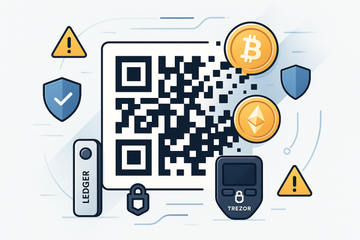Ever spotted those mysterious black-and-white squares on flyers, websites, or even a friend's phone and wondered what sorcery they hold? That, my friend, is a QR code. Technically called a Quick Response code, it's a specialized barcode that can store a whole bunch of information—web links, payment addresses, texts—just by tweaking the arrangement of its little black modules. But here's the catch: while they’re everywhere these days, QR codes have quietly become a backbone for smooth crypto transactions. And if you’re even a little crypto-curious, you’ve definitely bumped into one.
From Factory Floors to Wallet Transfers: The Origin Story
QR codes didn’t start in crypto—they actually began in Japan, back in the nineties, invented by Denso Wave to keep track of manufacturing parts. Imagine needing to trace endless widgets on a production line, but wanting something faster and more flexible than standard barcodes. That’s how QR codes jumped onto the scene. Their ability to store hundreds of characters and work from any angle made them perfect for chaos-prone industries. Fast forward, and those same features keep our crypto coins zipping across borders without a hitch.
Making Crypto Payments Less Hairy
So, what hooks crypto folks onto QR codes? It’s all about hassle-free payments. You know how typing a long wallet address (with random letters and numbers) feels like walking a tightrope blindfolded? One slip and your bitcoin could end up in the ether—literally. QR codes make this part much less stressful. With a quick scan, your device fills in the wallet address, slashing the risk of human error. Trezor and Ledger wallet owners, in particular, swear by this. These hardware wallets—kind of like armored vaults for your coins—let you generate QR codes natively to share your wallet address or send funds.
Picture this: you’re buying coffee, the barista pulls up a QR code for the shop’s Ethereum address, and you scan it with your phone. Voila—payment sent, latte secured. No fuss, no crossed wires. That’s the magic in action. So next time you see a QR, remember, it might just be the unsung hero behind your flat white.
Ledger, Trezor, and the Trust Factor
Let’s get real for a second—security is king in crypto. While QR codes make things smooth, they also open the door to some risks if you aren’t careful. That’s where big names like Ledger and Trezor come in. Their hardware wallets use QR codes for address sharing but keep your private keys locked up tight, away from phishing or malware. If you’re hands-on with these devices, you’ll notice they never show private keys as QR codes—only public addresses. Why? Because anyone with your private key QR could walk off with your life savings. Not a nice thought, right?
Here are a few golden rules if you want to keep your crypto safe:
- Always verify the code: If you’re sending funds, double-check that the QR matches the intended wallet address. Don’t just point and shoot—be wise.
- Never share your private key: Seriously. Only public addresses go in QR form. Don’t fall for fancy scams asking otherwise.
- Watch for tampering: In the wild, printed QRs at cafés or shops can be swapped for malicious codes—especially during busy events or in places with low oversight.
Ledger, Trezor, and other hardware wallets make it almost impossible to accidentally reveal sensitive keys as QR codes. But honestly, if you find yourself second-guessing a QR code source, trust your gut. It’s better to be paranoid than poor.
QR Code Security: Not Always a Bed of Roses
This might sound dramatic, but attackers have gotten clever. There have been stories of hackers sticking phony QR code stickers on top of real ones at payment terminals, redirecting funds to themselves. That’s why if you see someone fiddling with a QR code sign in a shop, maybe raise an eyebrow—or two.
Also, while mobile wallets like Trust Wallet or MetaMask scan QR codes directly, you should keep your phone’s security up to snuff. Malware can lurk in dodgy QR scanners. Stick to the built-in camera or trusted apps. A solid rule? Don’t scan QRs from suspicious sources or sketchy websites, no matter how desperate you are to win that crypto giveaway.
Handy Tips for Smooth Crypto QR Code Use
- Double-check transaction details after scanning, especially amount and address.
- Update your mobile wallet apps regularly.
- Use 'display only' settings on wallets like Ledger or Trezor to show QRs without the chance of sending info out.
- For extra peace of mind, generate QR codes offline using your hardware wallet interface, not random browser sites.
Some folks get adventurous, printing QR codes with their wallet addresses on business cards or stickers to encourage tips or micro-donations. Cool idea? Definitely, but remember, print is permanent. If you ever change wallets—or get pestered by a spammer—you can’t unscan what’s already handed out.
Beyond Crypto—QR Codes Are Everywhere (for Good Reason!)
Truth is, the world has fallen in love with QR codes. Restaurants ditched menus and now you scan a code for a digital one. Event tickets, boarding passes, even some sneaky marketing tricks from your favorite soda company—all use QR codes. They’re like sticky notes for the digital era, only with superpowers.
And with the rise of contactless everything—thanks, global pandemics—QR codes aren’t fading anytime soon. Just be sure, in your crypto adventures, that you’re scanning and sharing them with care. Like street food stalls, some QRs are legendary and delicious; others, not so much.
The Last Word: QR Codes, Crypto, and You
At this point, QR codes have become second nature—in crypto and almost everywhere else. Their ability to make tricky stuff accessible with a single scan is pure genius. But a little caution goes a long way. So next time you flash your phone at a QR code, take a beat, check the details, and celebrate how modern magic makes sharing digital gold as easy as snapping a selfie.











